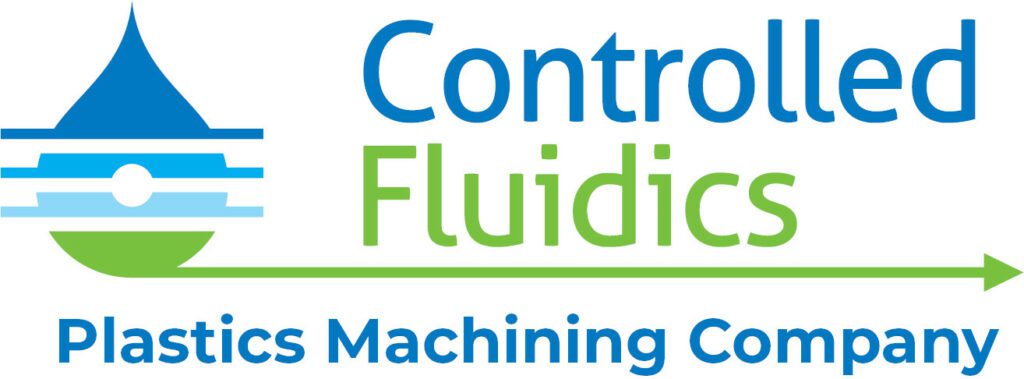Plastic Machining vs 3D Printing: Which Is Better for Plastic Parts?
Controlled Fluidics is very selective about the technology, procedures, and materials we use to serve our clients. Our clients use plastic components in the healthcare industry, aerospace, scientific research, and more. Often critical to the proper functions of the device, our parts perform in high heat, high pressure, and chemically aggressive environments.
For these reasons, we favor plastic machining with 5-axis CNC machines over 3D printing. Read on to find out more about our thought process behind this decision.
Is CNC Plastic Machining the Same Thing as 3D Printing?
The primary difference between plastic machining and 3D printing is a matter of addition versus subtraction. 3D printing is an additive manufacturing process that builds the contours of the components one layer at a time. 3D printing needs little in the way of setup time, specialized fixtures, and tooling, so the process is efficient for low quantity runs.
CNC plastic machining is a subtractive manufacturing process. We start with a solid block of source material, which we call a “blank.” We then use subtractive machining to remove material from the blank to reach the desired form.
CNC machining uses different rotating cutting tools to reach the exact specifications. Our advanced machining techniques employ 5-axis machines that operate on three linear axes and add two additional rotating axes, improving accuracy and lowering cost. Sharp cutting tools move smoothly over the material, rotating with its movements so that the shop worker doesn’t have to remove and reposition the component. We use short cutting tools that reduce vibration and produce a smoother finish while providing the industry’s best burr minimization.

Why We Choose Plastic Machining
Why we choose to machine plastic components instead of 3D printing:
- Plastic machining is appropriate for jobs from a single piece to high-volume production.
- For high-volume projects, this method of plastic fabrication saves time and money.
- Plastic machining produces parts that can be large or micro with a high degree of quality.
- Plastic CNC machining can produce thin component walls that are still strong enough for high-stress use.
- Plastic machining is accurate and can produce the tightest tolerances available.
- Plastic machining offers a greater range of surface finishes.
- A greater variety of plastic materials can be CNC machined.
- Plastics can have a high resistance to chemicals
- External and internal features have a smooth finish
- FDA, radiation resistance, UV resistant, USP class 6, NSF, 3-A compliant materials
Disadvantages of Plastic Machining
There are few disadvantages to CNC plastic machining, but they do exist. The drawbacks are that CNC produces more waste material from the subtractive process and setup costs are higher for small quantity runs.
When to Think About 3D Printing
There are some circumstances where 3D printing will serve a client’s needs better.
- When materials are not easily machined but printable, such as TPU and certain metal superalloys.
- Complex geometries and configurations that are not machinable.
- For prototype runs, 3D printing can be more cost-efficient because of limited setup.
- Best for single piece flow and allows for quick testing of design concepts.
- Faster turnaround time for small quantities.
- Capable of internal 3d structures
Why Not to Use 3D Printing
While 3D printing can be good for making small samples of components that will be machined later, they are not often used for final functional testing as they do not have the same properties and finish of the machined component. These are some more examples of why we prefer plastic machining over 3D printing:
- Throughput is limited for production quantities because of long printing times.
- Design flexibility and performance is reduced because of limited material choices.
- Most materials for 3D printing cost more than plastic sheet or rod.
- 3D printed parts can have lower tensile strength.
- Components over a certain size can’t be accommodated.
- Surface finishes can be rough.
- Limited chemical resistance.
Get a Quote For Our Machining Services
We provide comprehensive support for each project from beginning to end, including help with design. Our experienced professionals inspect each prototype to see that each requirement is met. To get a quote and learn more about our machining services, please provide these specifications:
- Provide your plastic material choice (if you are not sure, please specify "unsure" and our professionals can help).
- Provide a drawing of the component.
- If you only have a solid model, please specify threaded holes. Tolerances of +/-.005 assumed unless noted otherwise.
- Note the number of pieces you will need/the volume of your order.
- Your optimal delivery date.
Contact us anytime to talk about your needs and ask questions. We look forward to hearing from you.
